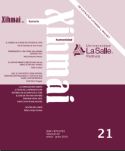Brechtian Distancing Works of Michael Haneke
DOI:
https://doi.org/10.37646/xihmai.v11i21.268Keywords:
Haneke, Brecht, identification, distancing effect, appealsAbstract
This essay addresses four issues: the first is to make visible the influence of Bertolt Brecht in Michael Haneke, through the various forms of Brechtian alienation in his works; the second is the film policy of director, whereby he tries to make the viewer a critical agent that can distance for a judgment of artistic representation and take on responsability for his spectatorial place; the third is to explain the method of the filmmaker, from a formal analysis of his works, in order to recognize the main elements of its film policy, aesthetics and ethics; and the fourth is to note that while the director considers himself an artist and not a theorist, his frankfurtian ascentry take him to seek social transformation through a subjective warning. February, 2015.
Downloads
References
ADORNO, T. (2007). Dialéctica de la ilustración, traducción Joaquín Chamorro Mielke. Madrid: Akal.
BENJAMIN, W. (2012). Escritos franceses, traducción de Horacio Pons. Buenos Aires: Amorrortu.
BRECHT, B. (1983). El pequeño organon para teatro. Granada: Don Quijote.
BRECHT, B. (2000). Cinco dificultades para decir la verdad, sin traductor. Mientras tanto, 77, 53-62.
DEBORD, G. (2008). La sociedad del espectáculo, traducción de Fidel Alegre. Buenos Aires: La marca editora.
LEBEL, J-P. (1973). Cine e ideología, traducción de Julio Crespo. Buenos Aires: Granica Editor.
FREUD, S. (1998). Lo ominoso, traducción de José L. Etcheverry. Buenos Aires: Amorrortu.
METELMANN, J. (2010). Fighting the melodramatic condition. Haneke's polemics, en Grundmann (ed.). A companion to Michael Haneke (168-186). Singapore: Wiley-Blackwell. https://doi.org/10.1002/9781444320602.ch9 DOI: https://doi.org/10.1002/9781444320602.ch9
NEHAMAS, A. (2005). El arte de vivir: Reflexiones socráticas de Platón a Foucault, traducción de Jorge Brioso. Valencia: Pretextos.
PEUCKER, B. (2010). Games Haneke Plays, en Grundmann (ed.). A companion to Michael Haneke (130-146). Singapore: Wiley- Blackwell. https://doi.org/10.1002/9781444320602.ch6 DOI: https://doi.org/10.1002/9781444320602.ch6
PIGLIA, R. (2000). Plata quemada. Barcelona: Anagrama.
PUELLES Romero, L. (2011). Mirar al que mira. Teoría estética y sujeto espectador. Madrid: Abada Editores.
RECALCATI, M. (2014). El complejo de Telémaco, traducción de Carlos Gumpert. Barcelona: Editorial Anagrama.
TODOROV T. (1991). Crítica de la crítica, traducción de José Sánchez Lecuna. Barcelona: Paidós.
Downloads
Published
How to Cite
Issue
Section
License
Copyright (c) 2016 Aliber Escobar

This work is licensed under a Creative Commons Attribution 4.0 International License.
Authors who publish in this journal agree to the following terms:
Authors retain copyright and grant the journal right of first publication, with the work licensed under a Creative Commons Attribution 4.0 License, which allows others to use the published work as long as they acknowledge the authorship of the work and its first publication in this journal.
Authors may make separate, additional contractual arrangements for non-exclusive distribution of the published version of the article in this journal (e.g., posting it to an institutional repository or publishing it in a book) as long as they clearly indicate that the work was first published in this journal.
Authors are permitted and encouraged to share their work online (for example, via institutional repositories or personal websites) prior to and during the manuscript submission process, as it can lead to productive exchanges and to increased and more rapid citation of the published work.









